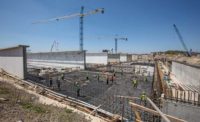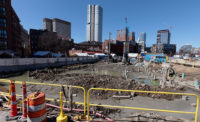Two giant anaerobic digesters shaped like Faberge eggs have for years served as landmarks for commuters traveling on Interstate-695 east of downtown Baltimore. And cranes, recently removed, signaled the location of one of the latest projects in a years-long, $1.6-billion construction program to upgrade the 100-year-old Back River Wastewater Treatment Plant. “You probably won’t see a collection of this many ‘sticks’ anywhere else in the city,” Shane Lippert noted back in October.
Lippert is the project director for the Clark Construction and Ulliman-Schutte joint venture building the $429-million headworks and wet weather flow equalization improvements, which is the largest undertaking by Baltimore’s office of engineering and construction. The 45-acre project’s goal is to eliminate 80% of the city’s current sanitary sewage overflow volume by increasing influent capacity to 600 million gallons per day from 469 mgd. The facility will have the potential to increase future capacity to as high as 752 mgd.
It is also the city’s first construction manager at-risk project on any infrastructure project. Baltimore deployed the Clark-Ulliman-Schutte JV as the CMAR in 2016, a year after design-bid-build bids came in $100 million over budget. Now the CMAR, which broke ground a month after signing a guaranteed maximum price contract in July 2017, is under the gun to meet a Dec. 31, 2020, federal consent decree date. If the deadline is missed, the city will pass liquidated damages up to $25,000 per day onto the JV.
The scope involves relieving a hydraulic restriction by diverting flow from two chronically clogged influent sewer mains. The team will also install a set of four 800-hp pumps and a set of four 1,500-hp pumps as well as two above-grade tanks with a combined 36 million gallons of storage for wet weather. The team is building six major structures, including an influent pumping station and coarse screens located inside one 45,000-sq-ft building. A 15,000-sq-ft fine screen facility, a 56,000-sq-ft grit removal facility and two 260-ft-outside-dia, 18-million-gallon equalization tanks are also being constructed. Some existing structures will be renovated while others will be demolished.
Rudolph S. Chow, the director at the city’s Dept. of Public Works, would have preferred to try his department’s first CMAR on a smaller stakes project but says he’s “pleased” the work remained on schedule and on budget at ENR’s press time—despite Baltimore’s wettest year on record last year. “I knew that the headworks project would be one of the most expensive and important environmental projects we would be taking on in nearly a century, and we had to get it right,” Chow says. “Issues, as they come up, are being tackled with a sense of urgency … CMAR is proving to be a viable option for large, complex jobs.”
Atypical CMAR
When bids were opened in 2015, they came in 29% above the $350-million budget. The reasons were a tight labor market and looming consent-decree deadline, according to an independent bid reviewer. Instead of bringing on a CM at 30% design, city officials pursued the CMAR after design was complete, to keep better control of cost and schedule. The city “kept the same designer and engineer to stamp drawings at the end of the day,” Lippert says. “It’s not your typical CMAR.”
The engineer of record, Johnson, Mirmiran & Thompson Inc., and the CMAR ultimately shaved approximately $90 million, or 20%, off the project cost, adjusted for inflation. The majority of the savings came from changing management of the excess flows, thereby eliminating the need for an equalization facility with a 3-million-gallon wet well.
JMT and the CMAR value-engineered the project during preconstruction while the early guaranteed maximum price allowed the JV to get an early start on excavating the 40-ft-plus-deep influent pump station (IPS). “That allowed us to get the most critical portion to meet the consent decree going early, as we were still trying to figure out how to save money on the remainder of the facility,” Lippert says.
JMT also continued to help the city create CMAR contracts from scratch during the nine-month preconstruction period because the city had no boilerplate documents, says Ben Asavakarin, a JMT vice president. Before then, the engineers spent three months drafting the contracts to advertise and select the CMAR and another three months getting them to meet city charter requirements.
The JV also worked hard to “assimilate” Baltimore to the CMAR process, says Monty Simon, the city’s former project manager, by hosting learning sessions and “taking the time to actually go through the decisions and to answer the questions.”
The original 2002 consent decree to rehabilitate Baltimore’s decaying sewer system set a 2015 deadline, but the recession made it difficult for the city to meet the deadline.
In 2017, Baltimore successfully renegotiated the original deadline and got an extension to 2020 after submitting a more cost-efficient plan than the original one to increase pipes and storage tanks, says Asavakarin.
Waterfall effect
The headworks is the keystone in what is an overall $1.6-billion program. The hydraulic flow, including the influent pumping station, represents a “fundamental rethinking of wastewater conveyance” at the plant, says Jerry Jurick, JMT senior vice president. The century-old facility’s original design relies on gravity flow into the plant. Jurick says that “inadvertently” creates a hydraulic restriction, in which conduits are lower than the downstream treatment facilities. “Influent flows are flowing uphill,” he says, which results in sewage pipe backups as long as 10 miles. “The headworks project will eliminate this hydraulic restriction by allowing the flow to drop into a new, deep junction chamber, similar to a waterfall effect,” Jurick says.
“The headworks program will eliminate this hydraulic restriction by allowing the flow to drop into a new deep junction chamber, similar to a waterfall effect.”
– Jerry Jurick, Senior Vice President, JMT
Creating that “waterfall effect” involves building the influent junction chamber (IJC) below the two restricted sewer mains—a 110-year-old, 12-ft by 12-ft arched concrete pipe; and a 76-year-old, 11-ft by 11-ft concrete box sewer. The new IJC facility, a 138.5-ft-long by 19-ft-wide concrete structure, will be constructed around parallel sections of the sewer mains.
An 80-ft-long by 20-ft-wide hanger system of steel beams, piles and bars supports the existing sewer mains during excavation work for the IJC. “It’s like building a suspension bridge to hold the pipe up,” Asavakarin says. After the IJC is completed, the flow into each section of the sewer main inside the chamber will be eliminated, one at a time, using temporary steel bulkheads on the upstream side and wood stop logs downstream. The two decommissioned sections of parallel pipe, each of which is 14 ft long and 17.5 ft wide, will be sliced into smaller pieces using a wire saw. Those smaller sections will then be removed by crane.
A permanent concrete bulkhead installed on the downstream side of the IJC will prevent water from entering the existing headworks, forcing the water into the new headworks. “The IJC includes water control measures that will not allow the water to enter the IPS until after the IPS is complete,” Lippert says.
Determining the facility’s optimal hydraulic flow involved hiring Seattle-based modeling firm Northwest Hydraulic Consultants Inc. to build a one-seventh-scale physical model in Vancouver, British Columbia. The design team traveled to Canada in 2016 to observe flow being sent through the replica model “to prove that the design will actually work,” Asavakarin says.
But project officials say they won’t know whether the process will work until the facility is activated in late 2020.
Collaboratively resequencing work on the fly is critical for an accelerated project in which nearly every work item is on the critical path, Asavakarin says. The team relies on a live BIM model centrally held by the CMAR but accessible to all team members. “Decisions just need to be made faster,” Asavakarin says.
Water logged
That level of collaboration to maintain the critical path became crucial when Baltimore received a record-setting 72 in. of rainfall in 2018. To save time, the team revisited a plan to install pumps before installing the pump station roof, Asavakarin says. Instead of installing the pumps before placing structural steel, the team resequenced the structural deck with openings just large enough to use cranes to bring in the eight 10-ft-dia pumps.
The rain did hamper excavation and concrete work. But Lippert says the team minimized the effects on excavation work by relocating the electrical substations so that work could begin on the substations during concrete and utility installations. He says the design required the concrete and utilities to be installed before the substations could be built.
Another challenge was hiring the quantity and quality of workers needed to complete what typically would be about four years of work that needs to be completed in two-and-a-half years. The CMAR’s ability to split several bids into smaller packages helped. Concrete work totaling about $97 million was bid in six separate packages. “We were able to get the larger subcontractors to do portions of it, as opposed to one general contractor trying to do everything,” Lippert says.
The project is also on track to meet “best-faith efforts” set in the GMP for minority and women-owned firm hiring goals. At ENR press time, the CMAR had awarded contracts to MBE firms equaling 12.8% of the overall contract value and to WBE firms totaling 5.5% of the overall contract value, not including second- and third-tier participation, “which is allowed by contract,” Lippert says.
Even though the project is moving quickly, there have been no lost-time accidents at press time during 580,000 worker-hours. The project team members are united by the consent decree—which, while daunting, fosters a common purpose. “The amount of interaction between the team is far more than I’ve ever seen,” Jurick says. Most importantly, Lippert says the CMAR is helping meet the project’s schedule and cost demands. “We’re not there yet,” he says, “but it has helped to hopefully make sure that we meet the consent date.”











Post a comment to this article
Report Abusive Comment